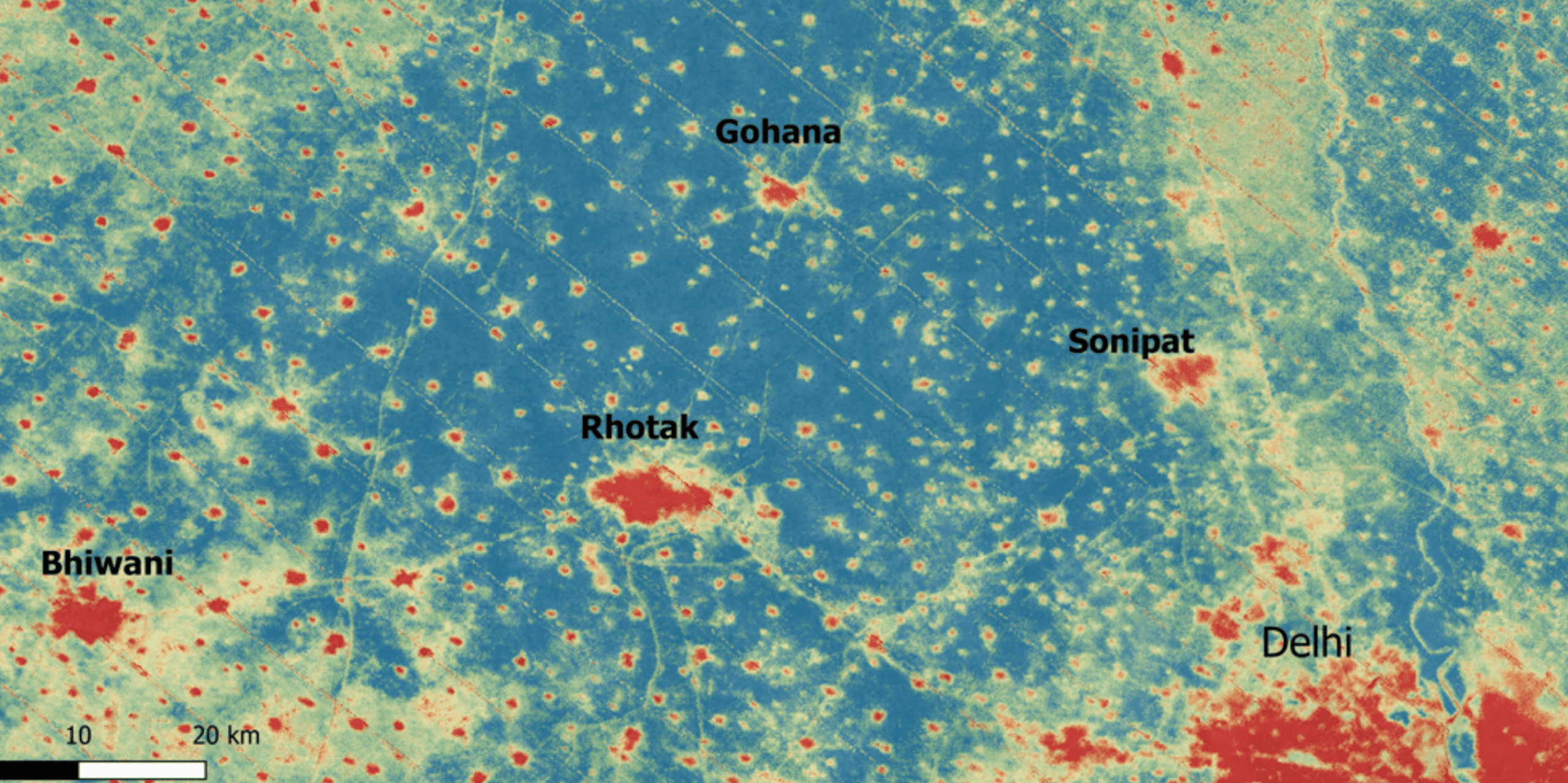
India has been witnessing extreme “heat islands” phenomenon across the North-West, causing massive deaths, intense wildfires, and severe air pollution. It also severely impacts crops productivity and leads to food insecurity for millions…
A satellite image of NASA shows a clear delineation of “heat islands” from open agricultural fields of hinterland in the North-West region. The phenomenon is defined as experiencing higher temperatures than outlying areas. NASA’s Ecosystem Spaceborne Thermal Radiometer Experiment on Space Station instrument (ECOSTRESS) has been measuring heats from space. The image clicked around before midnight of 5 May 2022 (See Photo).
The photo represents a scattered red color patches of urban areas and human habitations as “heat island” which depict ground temperature Delhi and near Delhi areas. The temperature peaked at around 39 degrees Celsius in urban and human habitations while nearby fields, represented in sky-blue color, where temperature dropped were about 15 degree Celsius. National capital Delhi has been depicted as a big ‘heat island’, followed by smaller cities such as Rohtak, Gohana, Bhiwani, Sonipat and hundreds of villages. The image covered over 12 thousand square kilometers area which house around 28 million population.

Most of the urban areas and smaller human habitations are experiencing severe heat wave even at night. The trend of increasing night-time heat island phenomenon is worrisome for India when one-third of its population reside in cities, around 7 percent of global population (Journal of Environmental Management).
“Cities and other human habitations environment built of different materials like metals, stones, roads, etc. and number of human activities like cooking, energy consumption, transportation contribute in increased land surface temperature” says Dr Ashim Mitra, senior scientist, Indian Meteorological Department (IMD). Dr Mitra also warns of global warming soon becoming a day “heat island” phenomenon as well.
“An ongoing study shows there is temperature difference of 5-7 degree Celsius from surrounding in day time” he said.
The LST are different from the air temperatures. Traditional weather report measure air temperature in the shade and have been recorded between 40-50 degrees Celsius, which is also very high. According to IMD, a heat wave occurs when the temperature crosses 40 degrees Celsius in the plains, 37°C in the coastal areas and 30°C in the hills.
On April 29, the LST temperature collected as 62 degree Celsius reported by European Space Agency which tweeted by ADAM platform, a geospatial data management platform.
“After this information, we also verified by analyzing our data from INSAT 3D satellite and observed similar pattern. We also tweeted this information but later removed as it created confusion” said a senior scientist, close to development, at IMD headquarter Pune, who doesn’t wish to be named.
“The LST requires more nuanced view as it cannot be generalized” he said. “Like sand or asphalt get heated under the sun and it cannot be interpreted as general temperature.”
While urban landscape is sweltering in record heatwave, the far flung forests area is no more immune to this heat wave. There is a series of fierce fire reported from Northern parts of the country such as Jammu and Kashmir, Uttarakhand and Himachal Pradesh.
In April, a Himalayan state Himachal Pradesh reported around 750 forest fire instances, while another hilly state Uttarakhand, also nestled in the Himalayan terrain, reported 1,500 forest fire incidents. Just on a single day, April 30, Uttarakhand witnessed over 50 fire incidents, highest among all states ever recorded in a day. On May 20, a massive fire broke out in Nagrota forest in Jammu. It spread towards Line of Control which triggered over half-a-dozen land-mine blasts in the area. Besides, there are reports from many agricultural field fires in different parts of the Jammu and Kashmir state. These forest fires release greenhouse gases such as carbon dioxide and fly dust, choking city dwellers.
According to Centre for Science and Environment (CSE), a Delhi-based non-profit, the country reported 280 heat wave days from March 11-May 18, 2022 — the highest in 10 years. There is no centralized data collected in the country to keep record of heat wave induced causality. Only in April, a western state, Maharashtra reported 25 deaths due to heat wave.
In 2019, government informed the parliament that over 6,100 people have died in India due to heat wave in the last nine years (2010-18) with the year 2015 alone recording nearly one-third such deaths.
According to the WHO, more than 166 000 people have died due to heatwaves, including more than 70 000 who succumbed to the 2003 heatwave in Europe between 1998-2017. Between 2000 and 2016, the number of people exposed to heatwaves increased by around 125 million.
In March, rising temperature broke 122 years record which affected wheat production by 10 percent. India was expecting the total produce to be around 111 million tons (MT), but after early heat wave the estimation reduced to 105 MT.
Grain traders estimate total production way below 100 MT. It made India to have a reckoning with food crises. The government was unable to procure enough grains for the poor populace which depends on cheaper foodstuffs. India also put a ban on the export of wheat which drew sharp criticism from the international community.
© Geospatial Media and Communications. All Rights Reserved.